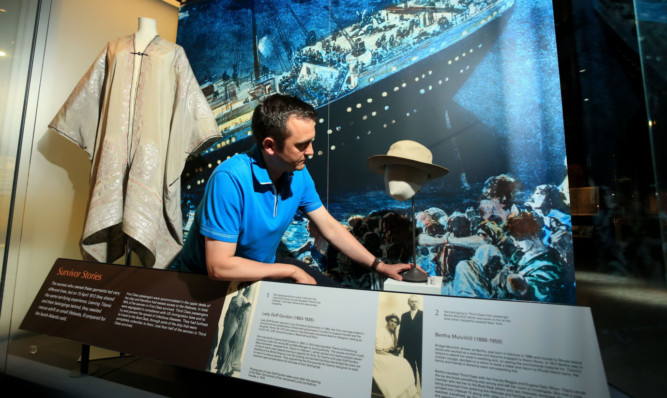A luxurious robe belonging to one of the Titanic’s most controversial survivors has been added to a popular exhibition about the doomed liner.
Fashion designer Lady Lucy Duff Gordon and her husband Sir Cosmo Duff Gordon escaped the sinking ship on the so-called “millionaires’ lifeboat” and faced allegations they bribed crew members not to return to save others for fear the half-full boat would be swamped.
They always vehemently denied the claims, and the bribery accusations were subsequently rejected by an inquiry into the sinking, but the story still entered Titanic folklore and has endured more than a century on.
The intricate kimono-style robe worn by Lady Duff Gordon on the night of the sinking in April 1912 has now be purchased at auction by National Museums Northern Ireland, supported by the Heritage Lottery Fund, and put on display in an exhibition at the Ulster Folk and Transport Museum in Cultra, Co Down.
The international designer, who ran the fashion house Maison Lucile, reputedly lost a wardrobe full of other expensive garments in the disaster, including three fur coats.
Encapsulating the social gulf between passenger classes on board the ship, a more modest item from a third class traveller has also gone on display at the exhibition.
The hat given to Irish American woman Bertha Mulvihill when she arrived in New York on the rescue ship Carpathia was donated to the museum by her ancestors.
Ms Mulvihill was born in Athlone, Co Westmeath, and moved to Rhode Island where she worked as a waitress.
In 1912, she was in Ireland to attend her sister’s wedding and decided to buy a ticket for the Titanic on a whim to return to the United States.
Another artefact joining the collection at the museum is the tool set of William Bell, a ship fitter who worked on Titanic as it was built at Harland & Wolff in Belfast.
Mr Bell was on board for its maiden voyage from Belfast to Southampton, completing last-minute work. Ironically, he had expressed bitter disappointment at being unable to join the vessel as it sailed on to America.
William Blair, head of human history at National Museums Northern Ireland, explained the significance of the added items to the exhibition.
“The new additions to TITANIC a contain powerful and engaging human interest stories that build an extra element of drama into our interpretation of Titanic’s compelling history,” he said.
“The contrasting lives of Lady Duff Gordon and Bertha Mulvihill highlight the difference between first and third class passengers, while William Bell’s tool chest is a vivid reminder of the skill and dedication of the ship yard workers from the time.”
Also new to the exhibition are a series of Marconi gram radio communications which provide an account of the sinking as it happened, a collection of objects relating to the subsequent investigations into the disaster and three design plans of the Titanic and her sister ship Olympic.
Mr Blair added: “The new ship plans focus on the boat deck; the long deck plan gives visitors an insight into the area that was the scene of so much of the activity on the terrible night that Titanic sank.
“The Harland & Wolff design drawings of the ‘state of the art’ equipment to dis-engage lifeboats highlights how the fatal flaw was simply not having enough lifeboats on board. We look forward to welcoming visitors to this refreshed exhibition to learn something new about the story of Titanic.”
Further information can be found at www.nmni.com.
